There’s a lot of mystery here in our special Valley. On foggy, humid mornings, I wander out to a bejeweled, sparkling fairyland of — spider webs!
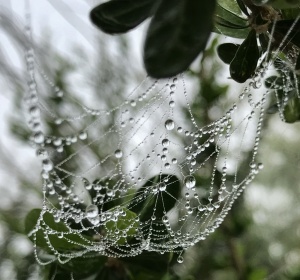
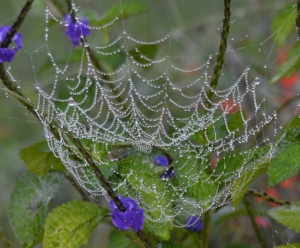
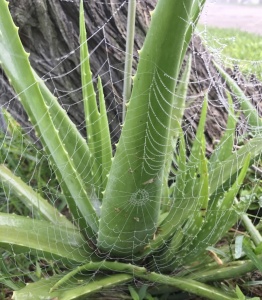
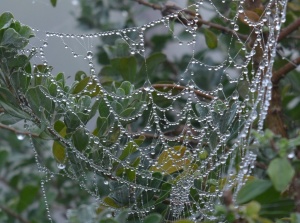
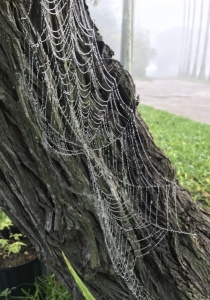
Orbweaver webs — they’re everywhere — fences, vehicles, furniture, plants and trees. And then suddenly, they’re gone!
This family of spiders includes nearly 3,500 species throughout the world making it the third largest family of spiders. About 180 species occur north of Mexico.
The orb weaver spider family is also one of the most varied — in size, shape, color and appearance — of all the families of spiders. Some have a flat abdomen making them look more like a tiny crab than a spider.
Most orb weavers are nocturnal, when they work to repair any damage on the web, and sit in the middle of it. For some species, once morning begins to arrive, the spider will tear down the web and eat most of the silk, benefitting from re-absorption of moisture plus consuming any dew that might have settled on the web. They will rebuild their web at dusk or during the night.
Orb weavers are docile, non-aggressive spiders that run or drop off their web at the first sign of a threat. They are not dangerous to people and pets, and are beneficial because they catch and eat pest-type insects.
Wasps, order Hymenoptera, on the other hand, have a bad rep, some of it deserved, when they aggressively defend nests built in garages, porches and under eaves of a house. However, wasps are extremely beneficial. Nearly every pest insect on earth is preyed upon by a wasp species, either for food or as a host for its parasitic larvae.
There are some 30,000 identified species of wasps and basically, two kinds: social (nest builders) and solitary. The vast majority of wasp species are solitary, non-stinging varieties — unless provoked. And all do far more good by controlling pest insect populations than harm.
An unusual sight caught my attention one day. A red tailed spider hunter, Tachypompilus sp. This wasp can hone in on wolf spiders, as this one did, dragging it across our driveway, around the rim of a plastic bin and then up a brick wall. The wasp moved backwards until I lost track of it in a shrub the other side of the wall.
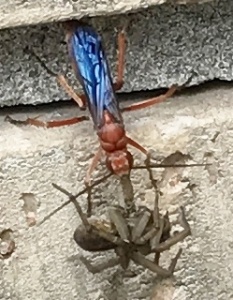
The red tailed spider hunter isn’t the only wasp that exhibits this behavior. Check my September 18, 2015 blog, “Interesting Visitors to Zizotes Garden” about the Tarantula Hawk wasp.
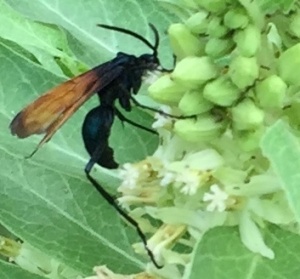
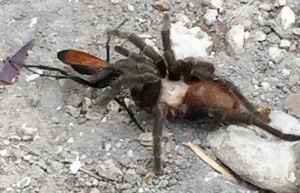
Spider wasps are in the family, Pompilidae. Tarantula hawk is a spider wasp that hunts tarantulas. It’s the largest wasp, up to two inches long, with blue-black bodies and bright, rust-colored wings.
The female stings and paralyzes a tarantula, then drags the prey to a specially prepared brooding nest, where a single egg is laid on the spider’s abdomen. The male does not hunt.
Adult tarantula hawks are nectarivorous and feed off the flowers of milkweeds, western soapberry or mesquite trees.
These huge wasps are relatively docile — truly, according to research — they rarely sting without provocation. However, the sting—particularly that of P. grossa—is amongst the most painful of all insects, though the intense pain only lasts three to five minutes — they say.
Let’s take a quick hop down a rabbit trail. There is a pain scale of insect bites recorded by entomologist Dr. Justin O. Schmidt. In terms of Schmidt’s scale, the tarantula hawk’s sting is rated near the top, second only to that of a bullet ant, named for its potent sting, and touted as the world’s most painful insect bite. Bullet ants inhabit humid lowland rainforests from Nicaragua and the extreme east of Honduras and south to Paraguay. Nothing to worry about in South Texas.
Schmidt not only rated stings, on a scale of one to four, he used dramatic description. For the tarantula hawk, “instantaneous, electrifying, excruciating pain.” For bullet ant, “. . . huge waves and crescendos of burning pain—a tsunami of pain . . . .”
Where the tarantula hawk pain lasted about three minutes, according to Schmidt, the pain from a bullet ant lasted 12 hours. Dr. Justin O. Schmidt wrote the book, “The Sting of the Wild.”
Back from the rabbit trail, some things just have a big ick factor. In the early morning, I often find black slugs on the driveway and sidewalk.
This Black velvet leatherleaf slug, Belocaulus angustipes, is not only invasive, it comes with a big caution.
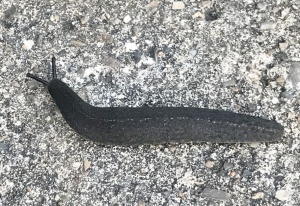
Belocaulus angustipes is jet black, with a leathery appearance and has two black ocular tentacles. The underside is tan in color. It can grow to three and a half inches in length.
Easy to recognize because the black velvet leatherleaf slug doesn’t closely resemble any native terrestrial slugs. It is found in all the Gulf states, South Carolina and Oklahoma.
That’s not the worst news. In Honduras, where it also is invasive, it was reported as an important vector of the nematode parasite Angiostrongylus costaricensis that causes abdominal angiostrongyliasis in humans.
Thankfully, the slugs have not been confirmed to vector this nematode in the United States. However, it’s recommended to not touch them. If you do, wash your hands in soapy water and then rinse them in alcohol or hand disinfectant. It also is recommended that you wear latex gloves or handle with a plastic bag around your hand.
See the June Chachalaca (out at the end of the month) for a more extensive article about these potentially disease-carrying slugs or Google: Black velvet leatherleaf slug Belocaulus angustipes, or click on the link: http://www.tsusinvasives.org/home/database/belocaulus-angustipes.
So much Art in nature. Thank You Anita
Oh, yes. It’s all around us, isn’t it? Thanks for the comment, Janet.
Thank you for all this information!
My pleasure. Thank you for appreciating it. There’s just so much mystery and intrigue going on under our noses — even in a simple butterfly garden!